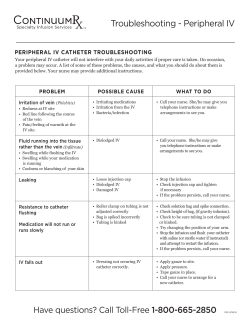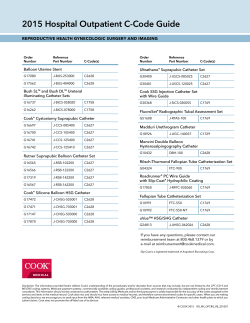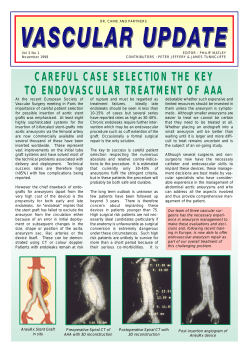
Vascular Access Systems Market
Vascular Access Systems Market Share, Global Trends, Analysis, Research, Report, Opportunities, Segmentation and Forecast, 2016-2026 Future Market Insights www.futuremarketinsights.com sales@futuremarketinsights.com Future Market Insights (FMI) is a premier provider of syndicated research reports, custom research reports, and consulting services. We deliver a complete packaged solution, which combines current market intelligence, statistical anecdotes, technology inputs, valuable growth insights, aerial view of the competitive framework, and future market trends. We provide research services at a global as well as regional level; key regions include GCC, ASEAN, and BRIC. Our offerings cover a broad spectrum of industries including Chemicals, Materials, Energy, Technology, Healthcare, and Retail. We have a global presence with delivery centers across India specializing in providing global research reports and country research reports. FMI is headquartered out of London, U.K., with a state-of-the-art delivery center located in Pune, India. We combine our knowledge and learning from every corner of the world to distill it to one thing – the perfect solution for our client. Research Capabilities Sector Coverage Customized Research Syndicated Research Investment Research Social Media Research Automotive and Transportation Electronics, Semiconductor, and ICT Retail and Consumer Products Industrial Automation and Equipment Customized Research Subscription Information Syndicated Research For detailed subscription information please contact Investment Research T: +44 (0) 20 7692 8790 | D: +44 20 3287 4268 Social Media Research Hari. T (Sr. Manager - Global Business Development) Email: hari.t@futuremarketinsights.com Chemicals & Materials Food and Beverages Services and Utilities Energy, Mining, Oil, and Gas Report Description Report Description Vascular access systems are intended for a series of diagnostic tests and treatments such as central venous pressure readings, blood sampling, fluid infusion, blood transfusion, parenteral and drugs administration such as chemotherapeutic agents, analgesics, antibiotics. Vascular access systems can be defined as the material which is implanted subcutaneously in a region over the upper chest wall, having a dwell time of nearly 14 days, with the catheters inserted in the sub clavian vein, jugular vein, or basilic vein. Central Venous Access systems are essential for the care of many sick children. In order to reduce the risk of infection and thrombosis and also to increase the line longevity, appropriate type of catheter must be selected and inserted in a standardized procedure. Vascular access systems market covers implantable-ports, Huber needles, (PICCs) peripherally inserted central catheters, (CVCs) central venous catheters, dialysis catheters, needleless connectors, needles and syringes. The usage of these medical systems depends on various medical conditions and its requirements that may include the purpose for its requirements, size of the device, the duration of time it needs to be in-situ. Peripheral vascular access systems are the most appropriate for short term therapies as they cause less irritation. A peripherally inserted central catheter is inserted through antecubital fossa vein, which may be basilica or cephalic, further progresses through the superior vena cava. The position of the catheter’s tip is radiologic ally confirmed. The procedure are relatively easy to insert. This makes them a potentially more economically option. The risk involved for the rate of thrombosis and sepsis is lowered. The risk of large vein perforation and pneumothorax is also reduced, which is linked to centrally inserted catheters. Whereas central vascular access systems are used in cases like medicines having greater pH than 9.0 or less than 5.0, parenteral nutrition with glucose concentration greater than 10%, infusion fluids which are known irritants, intra Report Description Report Description venous inotropes and vesicants. Tunneled central venous catheter are known as Hickman lines. These are more often required when the patient is on long-term infusion therapy, example chemotherapy, and total parentral nutrition and also provide access for taking blood samples. This type of line is manufactured in the form of large-bore silicone line having single or double lumen. Tunneled lines can be used for long-term infusion therapy with the time duration ranging from months to years. The tip of the catheter is directly inserted into the subclavian vein or jugular and then it is threaded through to end up in the superior vena cava. Various tunneled central venous catheters are equipped with a fibrous cuff. These are assembled in the skin tunnel. This enables the tissue of the patient to bond with the line so as to create a secure fix. This mechanical barrier stops infection from reaching the bloodstream to cause sepsis. These central venous catheters can be of two types, namely open-ended or valved. This type of line insertion is done usually in theatre or radiology with the help of an image intensifier for the correct positioning of the catheter. The non-tunneled type is often known as a short-term percutaneous central venous catheter and is most commonly used central venous catheter in secondary care. It is directly inserted into a central vein. Strict sterile conditions are required for the insertion of this type of catheter. The positioning of non- tunneled catheter is to be confirmed using radiological devices. The Jugular region (area near to the neck) is more susceptible to infection because of the difficulty of placing the catheter to the neck of the patient securely. Implantable ports are vascular access systems inserted into the chest, antecubital area or abdomen. They are useful in long-term intravenous therapy, blood sampling, bolus injections and total parentral nutrition. The recent advancement in the vascular access devices such as central venous catheter and peripheral inserted central catheters have lowered the use of implantable Report Description Report Description ports. Ports are inserted subcutaneously. Implantable ports are often preferred by the patient because they are less visible. Medical staff prefer them as they are linked with less risk and are easily accessed. These ports can remain in situ for up to seven days. Ports have been used for epidural pain relief and can be used alternatively for subcutaneous infusions. The condition of being unobstructed is maintained by rinsing heparin solution after definite intervals. It involves minimal manipulation and care. Request Free Report Sample@ http://www.futuremarketinsights.com/reports/sample/rep-gb1737 Vascular Access Systems Market: Drivers and Restraints As some of the central venous catheter can be in place for months together but replacement is required for few catheters due to the poor functioning. Certain types of ports have a life of reservoir septum of about 1000 puncture that is not at all suitable for patients who require daily IV access. Few patients have poor vein condition which is not at all suitable for placement of catheter. Long term access of the veins eventually lead to the vein damage (example: long term IV feeding). These all factors contributes to the restraints of the vascular access market. Globally, there is a constant rise in number of diseases like as cancer, trauma, and acute illness which has significantly raised the demand of proficient vascular access systems in recent years by healthcare professionals in hospitals, emergency rooms, and operation theaters. Further contributing to the driver for the vascular access system market. Report Description Report Description Vascular Access Systems Market: Segmentation • By Product • Central Vascular Access System • Central Vascular Catheter • Non tunneled • Tunneled • Implanted Ports • Peripheral Vascular Access System • Peripheral Catheter • Midline Catheter • By End User • Hospital Pharmacy • Ambulatory Surgical Centre • Hospital Pharmacy • Catheterization Lab • By region • North America • Latin America Report Description Report Description • • • • Eastern Europe Asia Pacific Excl. Japan Japan MEA Vascular Access Systems Market: Overview Depending on geographic region, global vascular access system market is segmented into seven key regions: North America, South America, Eastern Europe, Western Europe, Asia Pacific, Japan, and Middle East & Africa. North America holds the largest share of the global vascular access systems due to the cumulative aging population and extensive technological advancement. Visit For TOC@ http://www.futuremarketinsights.com/toc/rep-gb-1737 Vascular Access Systems Market: Region-wise Outlook Based on geographic region, global vascular access system market is segmented into seven key regions: North America, Latin America, Western Europe, Eastern Europe, Asia Pacific excluding Japan, Japan, and Middle East & Africa. North America holds the largest share of the global vascular access systems owing to the cumulative aging population and extensive technological advancement. Report Description Report Description Cluster Headache Syndrome Market: Key Players Nipro Medical Corporation, B. Braun Medical Inc., Edwards Life sciences Corporation, Medtronic, Siemens Medical Solutions Inc., Baxter, , GE Healthcare Inc., Teleflex Medical and. Becton, Dickinson and Company. Thank You! To know more about us, please visit our website: www.futuremarketinsights.com For sales queries or new topics email us on: sales@futuremarketinsights.com Future Market Insights: 616 Corporate Way, Suite 2-9018, Valley Cottage, NY 10989, United States T: +1-347-918-3531 | D: +1-845-579-5705
© Copyright 2025









